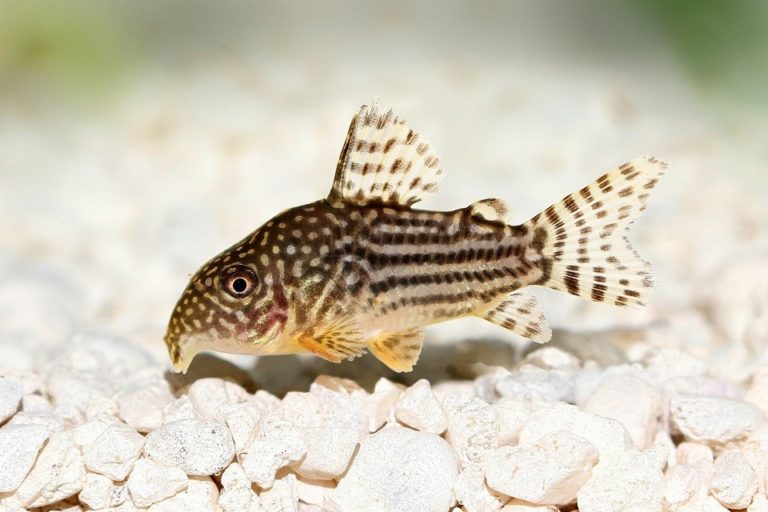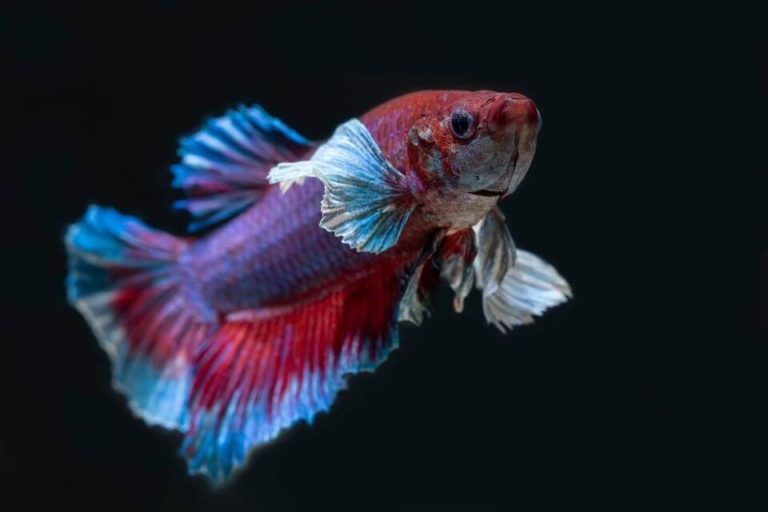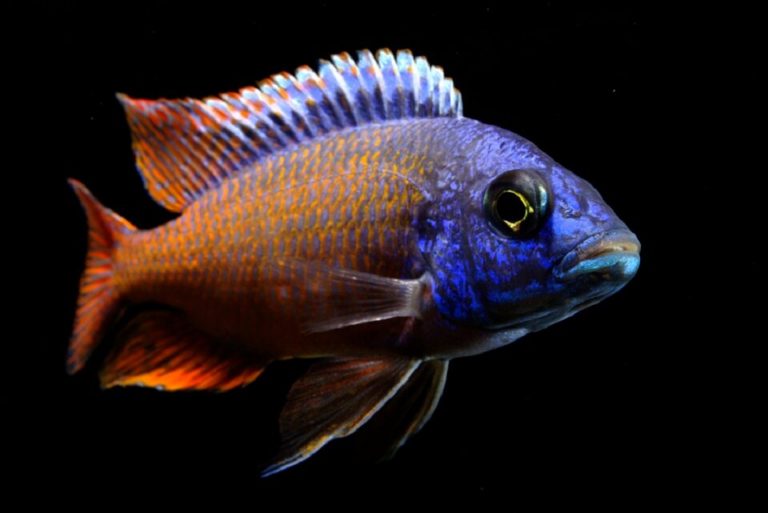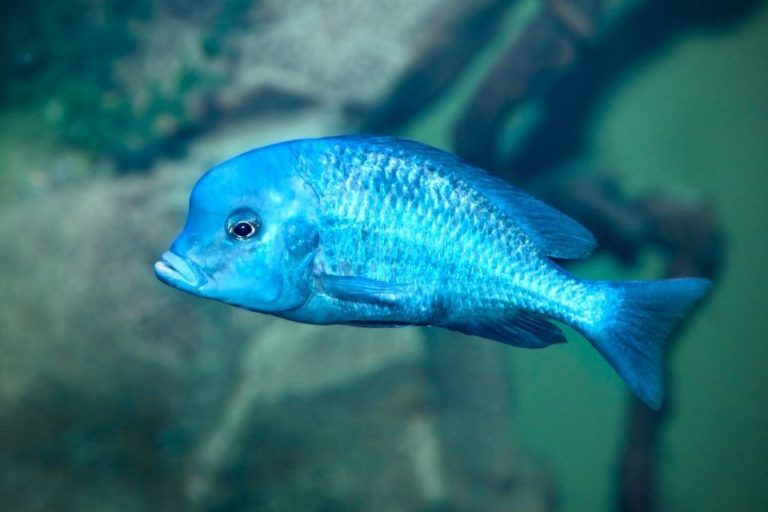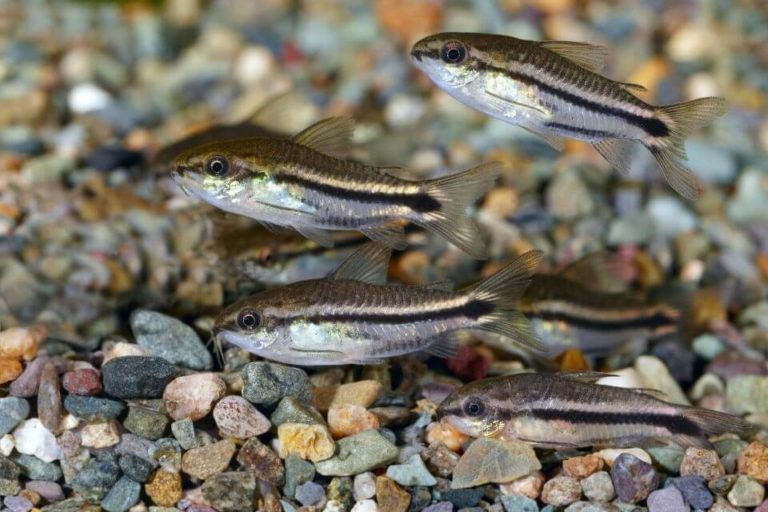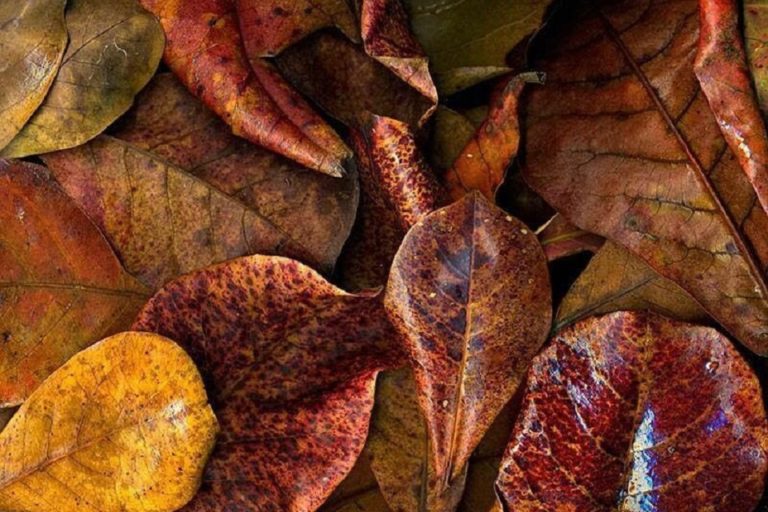Mystery Snail Care Guide and Species Profile: Food, Tank Mates and More
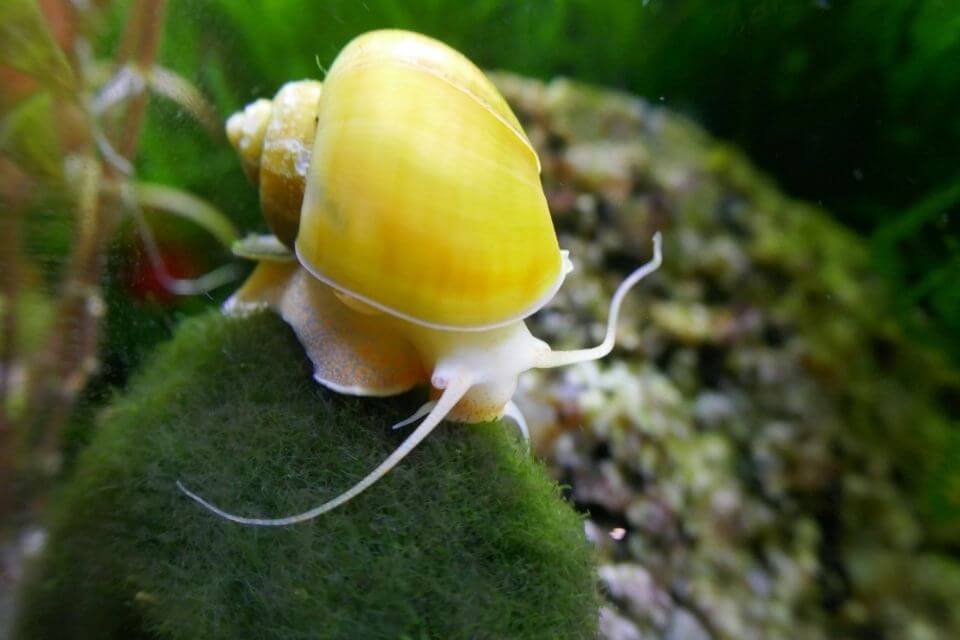
Mystery Snail is a docile and fascinating species of freshwater snails. These slow-moving colorful creatures will take your aquarium to another level appearance.
If you are wondering, they are referred to as “mysterious” because Mystery Snail females give rise to fully developed snails that appear suddenly, making them pretty mysterious creatures.
They have increasingly become a favorite among pet owners and a brilliant addition to aquariums. From the first sight of a mystery snail, you will not miss the captivating colors and various decorations on their shells.
Their body hues can range from gold, yellow, blue, green, purple, and brown, which may be solid, color gradients, patterns, stripes, spots, the options are endless- you never know what exactly to expect.
Species Overview
The Scientific name of the mystery snail is Pomacea bridgesii of Ampullariidae family, just like all other types of snails. Alternatively, it is commonly referred to as Mystery Apple Snail, Golden Mystery Snail, or Spike Topped Apple Snail.
Thanks to the different variations, their names are mostly drawn from their colors or the appearance of their shells. Also worthy to note other species of the mystery snail; the Chinese and Japanese snails.
They are scientifically known as Cipangopaludina chinesis (Chinese Mystery Snail) and Cipangopaludina japonica (Japanese Mystery Snail), respectively and are considered by some to be the invasive species.
These two were initially popular in the food trade circles for their larger size, whereas the Common Mystery Snails are aquarists’ favorite because they are smaller species.
Nowadays, Mystery Snails are widely kept as aquarium pets since they are very calm and peaceful and can cohabit with other creatures such as fish, shrimp, or plants.
Unlike the Chinese and Japanese species, these snails are not as invasive and do not grow to tremendous sizes.
Additionally, they stand out for their breathing and breeding techniques; they breathe through gills or through the tube extension that sticks out of their body. The tube is instrumental in collecting air above the waterline.
Origin and Distribution
The two common variations of the mystery snail are the Chinese and the Spike-Topped Snails. The Chinese Mystery Snails trace their roots from South East Asia.
They were initially brought to California in the 18th Century as a food source for the Asian markets. By 1915, there was evidence of the snail and records of its populations later in the 2000s.
They have since spread to many other parts of the U.S. and can be found in several Maine water bodies and ponds; however, their full distribution is unknown.
On the other hand, the Pomacea brigesi, otherwise known as Spiketop Apple Snail, is a South American native. Reports show the existence of this species of the mystery snail in Puerto Rico-a a U.S. territory.
They were also introduced into an Alabama pond park in 2003 and several other parts of the U.S. decades before then. They appear to be well-established in Florida waters. The Spike Top Apple Snail was introduced to the U.S. through the aquarium trade.
Mystery Snail Colors and Appearance
Mystery snails are pretty intriguing due to their wide color variations. The most popular variants are brown, black, ivory, and black, with their shells as the display.

The shells may come in solid colors, with different colored patterns, gradient hues, pop of color, and many more variations- the possibilities are unfathomable and almost endless.
Let’s not forget to mention Albino Mystery Snails. These have less pigment compared to the rest and are significantly paler compared to the rest. They are also interesting as they may have subtle patterns or hints of gold and brown stripes.
Anatomy of The Mystery Snail
There are notable differences in the Mystery Snail’s anatomy from that of other snails. One is that their apex is positioned more to the side of their aperture.
They also have an Operculum that looks like a giant nail (when the snail is closed). Their head is also a fundamental part of the mystery snail’s anatomy. They have two long and large tentacles that act as sensory organs in their environment and search for food.
Their eyes are situated directly behind the tentacles and help detect light and motion. The eyes and tentacles work together to help the snail find food and stay alert for predators.
You may notice that a snail tucks into its shell and closes the Operculum for safety in the face of danger. Well, this is thanks to these two organs.
However, two tentacles are not enough; the snail also has a second pair below its mouth for feeding. Lastly, it has a siphon positioned on the left side of its head that is useful in passing water through the gills.
Mystery Snail Size
Snails are measured in diameters and not their length, considering their build. Typically, a Mystery Snail can grow up to 2 inches in diameter, which is relatively big compared to other snail species.
Other Snail species tend to stick around like 1 to 1.25 inches in diameter. Although smaller sizes often indicate poor breeding or care.
A Mystery Snail can stop growing from a one-inch diameter and still be considered healthy and fully developed. Their younger ones tend to be a bit smaller, with a diameter of around 0.5 inches.
Their small size is a considerable factor contributing to their inclusion in small and large tanks alike.
Mystery Snail Lifespan
A Mystery Snail can live for about a year or a bit longer if they are lucky or depending on the water conditions. Mystery Snails are particularly sensitive to their environment’s needs.
It is not surprising that they die just shortly after they are transferred or added to an aquarium tank. Most sudden deaths are caused by differences in the water parameters and the stress of transportation from one point to another.
Behavior and Temperament
A Mystery Snail is a very peaceful creature and naturally non-aggressive. These snails care about hiding from danger than facing the danger head-on.
They enjoy their peace pretty much and do not care about anything else going on around them. Therefore if you are looking to grow your collection of aquarium creatures, then they are a perfect choice.
Unfortunately for them, Mystery Snails have little that they can use to defend themselves thus. Whenever they are spooked, the only option they have is to slide back into their shell, close the Operculum, and wait till things ease off.
These creatures can be very active but slow-mover, regardless of whether the tank lights are on or off. You will enjoy watching them as they steadily travel in the tank, harmlessly hunting for food and exploring different areas of the aquarium.
Most often they will take a break once they find a quiet spot. Occasionally, a Mystery Snail will travel to the top of the waterline and extend its siphon to collect some air.
It often happens when the tank lights are off. They also enjoy feeding in total darkness. It is also not unusual for Mystery Snails to appear dormant for a while. They may be very still in this state, and it is pretty easy to assume they are dead.
Mystery Snail Care
Mystery Snails are perhaps the easiest creatures to care for. They are not demanding, and their need is pretty straightforward. However, this does not mean you should neglect them either.
These Snail species depend on consistency for survival, and an unfavorable change in their habitat may lead to severe consequences. The following requirement is thus vital for them to thrive;
– Mystery Snail Tank Size
Generally, the aquarium dimensions are the primary limitations when it comes to tank size. The recommended tank size for a single Mystery Snail is about five gallons.
Most people add them to aquariums as cleaners, and indeed they do a great job. However, just as they clean waste, they also release some into the tank like other creatures. Therefore, overstocking mystery snails may do more harm than good.
The general rules of fish count come to play even more with the addition of Mystery Snails. It means that the one inch of fish per one gallon of water rule applies even to the cleaning crew. These snails thrive even better in a more prominent and well-established tank.
– Mystery Snail Tank Setup
Mystery Snails can be pretty adventurous; therefore, they need something to keep them busy in the tank aside from food. The first significant addition is substrate soil. Soil is a good choice if you plan on growing live plants in the tank.
However, not just any kind of soil will do as regular soil can mix with water and get muddy and murky. If growing live plants is not in the plan, then alternative substrates such as pebbles, gravel, and sand available in varying shades of brown or store-bought substrates are the go-to.
You can also decorate the tank with a selection of natural and artificial items. There are plenty of options from rocks, natural driftwood, shells, and different aquatic plants to add color and life to your tank if you care for nature.
You can also add artificial accessories such as plastic plants for longevity and plastic novelty items such as mermaids, plastic divers, or treasure chests.
Ceramic pieces and old glass jars are also great for the extra pop of color and hiding spots for your mystery snails. Lastly, you can use fun and exciting backgrounds to create illusions of different spaces and give the tank a cleaner finish.
Another fundamental feature is filtration. Essentially, three types of filters serve different purposes.
They include;
- Biological Filters: They decompose toxic ammonia that the aquarium creatures produce as waste. All aquariums must have biological filters.
- Mechanical Filters: Trap particles such as leaves and uneaten food making them easier to remove from the tank.
- Chemical Filters: Such as activated carbon and zeolite can remove ammonia, heavy metals, or other dissolved organics. These filters are effective for short-term problems such as purifying tap water.
Finally, lighting is mandatory; apart from showcasing the beauty of your tank, lighting also helps live plants grow. Fluorescent lights are the perfect fit as they run cooler and have a relatively lower wattage.
Terrible lighting could pose problems of overheating, especially in the summertime. If you want to grow plants and keep plants alive, you may opt for full-spectrum bulbs which mimic the sun’s spectral range.
Other elements to add to your tank include air pumps to maintain adequate oxygen concentrations, powerheads to circulate water throughout the tank, and heaters to steady the temperatures when it gets too cold.

– Water Conditions and Parameters
Mystery Snails are pretty sensitive, and their lives mainly depend on the consistency of their habitat’s conditions. Hence the need to regularly test the water in your tank.
You may be tempted to use untreated tap water in your tank for other fish; however, this is not advisable if you want your Mystery Snails to survive. Untreated tap water may introduce hazardous minerals to the tank, such as copper.
Note that Mystery Snails react adversely to copper and other minerals.
- Water temperature: 68 – 84 °F (20 – 29 °C)
- The acidity of water: 7.5 – 8.5 pH
- The hardness of water: 12 – 18 dKH
– Suitable Aquarium Plants
Plants not only serve as décor for your aquarium but also as food for the creatures in it while it natural plants will maintain the ecosystem of the tank.
Mystery Snails are not very picky; thus, you can experiment with a few options now and then. Some typical choices include soft, delicate plants such as Salvina, Hornwort, and Java Moss.
In addition to the Mystery Snails’ favorites, you can also go for hardy plants such as Anubias barteri, as they are most likely to live longer.
Ideally, the Mystery Snails are only interested in such plants after they are ruined, that is if they are well-fed or have other options.
– Mystery Snails Common Diseases and Prevention
Mystery snails are not particularly prone to any disease; that is one of the reasons why they are considered easy to maintain in the first place.
However, the emphasis remains on consistently keeping their water conditions conducive as mild changes can lead them into shock and eventually death.
Poor water quality also promotes the introduction of parasites which may aggressively attack the mystery snail. A parasite attack is almost impossible to treat and often results in death.
Copper is also another toxic substance to avoid at all costs as they often result in fatal reactions. Other diseases may lead to deformities in the snail’s anatomy, such as irregular shell growth.
It is not easy to tell if a Mystery Snail has a health issue unless kept under close observation. The easiest way to spot a problem is by monitoring its behavior and change in the usual activity level.
The best thing is to ensure the water quality is always safe.
Mystery Snail Food and Feeding
A Mystery Snail’s diet is very straightforward, primarily live plants, vegetables, and other natural food. These species of snails are scavengers and have a bounty of sources.
Their diet can be detritus and debris from shed plant matter in the tank or algae growing on leaves, stones, and other objects in the aquarium. You can also include supplements such as pellets, fish flakes, and algae wafers in their diet or test different vegetables to see what they like.
If they go uneaten for a day or two, then you probably need to take them out of the tank as soon as possible.
Mystery Snail Gender Differences
An exciting and mysterious fact about Mystery Snails is that they can switch sex from female to male and vice versa. However, unlike most snails, they are not hermaphrodites.
It is possible to identify the male and the female from their behavior and physical characteristics.
It is easier to distinguish the sexes during mating as the male mounts the female and delivers a packet of sperm with his penis, which you can observe from the front of his shell. On the other hand, the female lays eggs above the waterline or on the tank’s hood.
Another notable difference is the shapes of their shells. A male Mystery Snail’s shell has a rounder opening to accommodate the penis extension, and when it emerges from the shell, a penis sheath on the right side of its body is visible next to the gills. These features are absent in the female Snail.
Mystery Snail Breeding
Getting your Mystery snails to breed is as simple as putting a female and male in the same tank. Eventually, they figure out what to do. Some fish may require you to change the water parameters, more like setting the mood, to get some action underway.
However, breeding Mystery Snails is something anyone from a pet owner to an experienced Aquarist can handle. The trick lies in making sure you have both genders on board.
Mystery Snail Eggs and Babies
Mystery Snail eggs production increases as the weather become warmer, and you may begin noticing clutches on the waterline. There are several methods you can use to hatch the clutch or let them hatch on their own.
The female could lay eggs for up to five weeks. The air above the water must be moist enough to allow the Mystery Snail eggs to hatch within a month.
A single clutch may have very many snails; therefore, make sure you fully care for them before deciding to keep them. If not, you may need to freeze them as early as possible before throwing them out or selling them, but do not release them into the wild at all costs.
When they begin to hatch, you can transfer them into a smaller container with a bare bottom in their first month of life, making them easier to move around and find food.
Their environment must stay clean and have highly dissolved minerals to boost shell development. Baby Mystery Snails can feed on algae or seaweed, blanched greens, fortified frozen shrimp, or dehydrated home food.
Mystery Snail Tank Mates
Mystery Snails are very peaceful and prefer to be in equally calm environments. Therefore, any non-aggressive freshwater fish species that, of course, do not feed on Snails.
Some Mystery Snail mates are endless but some to consider:
- Otocinclus Catfish
- Ember Tetra & other Tetras
- Golden Wonder Killifish
- Least Killifish
- Cory Catfish
- Nerite Snails
- Ghost Shrimp
- Amano Shrimp
- Red Cherry Shrimp
Can Mystery Snails Live With Bettas?
Betta fish are a popular species for their active and interactive nature. Thus it is understandable that most aquarists may be curious to know whether they can get along with Mystery Snails.
The answer is yes; you can have these two in one tank. These two can pretty much stay away from each other’s business, and as the Mystery Snail cleans the water, the Betta Fish swims around to enjoy the water.
Do Mystery Snails Float?
Mystery Snails can float to the surface to collect air or when the water parameters are not conducive. Floating to them is mostly an escape mechanism from pollution.
However, if the snail stays afloat for a prolonged period or shows any unusual stillness floating could be an indicator of a problem. Therefore, you may need to remain observant for a while to determine whether the floating is regular.
How Fast Mystery Snails Move?
Most people may say “as slow as a snail,” but the mystery snail may surprise you. Although the statement is not false, you may catch a glimpse of a mystery snail moving very fast throughout the aquarium.
They also know how to have some fun by climbing to the water surface and rapidly falling freely to the bottom of the tank. As they proceed with their action, they may release large air bubbles from below their shells on their way down.
Our Mystery Snails Good For Your Tank?
Mystery Snails are great for your tank as they help clean up debris from shedding live plants, algae, and even uneaten food. By keeping the tank clean, they also make the environment friendly for other creatures in the tank.
Aside from that, they easily go unnoticed by other fish in the tank since they are very peaceful and are relatively easy to care for.
Why Is My Snail Hanging Out of Its Shell?
A snail may hang out of its shell for some time after breeding. However, if the body is hanging out and not moving, then it might be dead. You can confirm by touching its foot, no sign of motion may be a sign of a lifeless snail.
Where Can I Buy A Mystery Snail and Cost?
Mystery Snails are not easy to buy; you can get one or more from a pet store near you to avoid the extra shipping costs or online stores such as Amazon, eBay, Walmart, etc. The prices of Mystery Snails will vary depending on where you are buying them.
They can go up to $5 per Snail. The best deals are multiple packages as you stand to save more at wholesale pricing but most likely with an extra shipping fee.
Final Thoughts
Mystery Snails are the best additions to your tank. With all the necessary information, care should be a walk in the park. The best is that you can put them together with most of your favorite fish without the fear of causing trouble.
Apart from that, they help you keep the tank clean effortlessly and keep other creatures in the tank happy. Taking care of their babies is even easier as their ‘mysteriously’ adapt and find their way around the tank.
Mystery Snails are also a brilliant way to add variety to your aquarium without compromising the peace of other fish. Get yourself a few, and the population will eventually grow without you trying.


